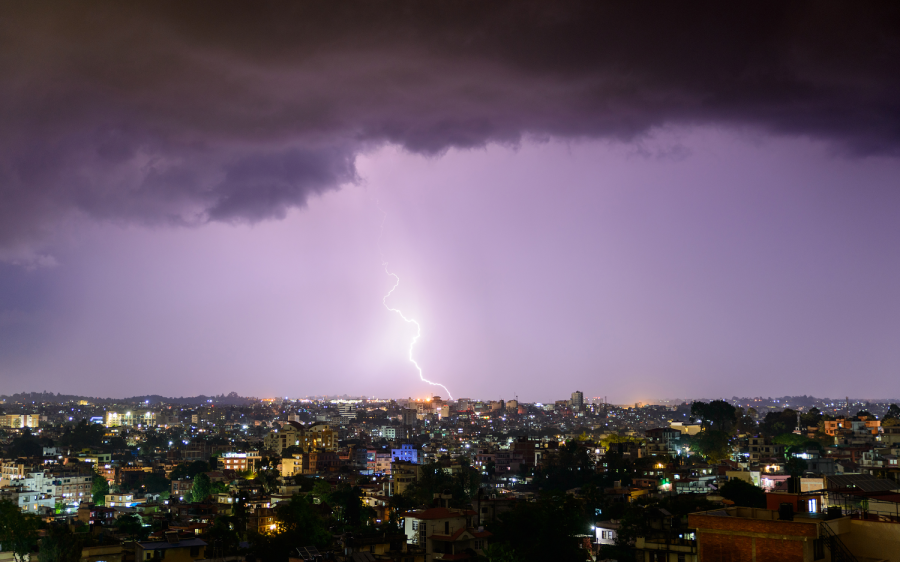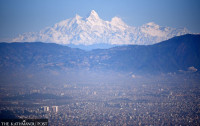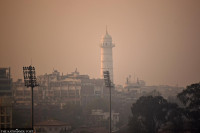Climate & Environment
Lightning strikes continue to kill people this pre-monsoon season too
Authorities rely on raising awareness programmes to bring down damages caused by thunderbolts.
Chandan Kumar Mandal
With the fully active pre-monsoon season, which is characterised by regular thundershowers and windstorms, the country is witnessing frequent deaths due to lightning, which remains one of the leading disasters of the country.
According to the National Disaster Risk Reduction and Management Authority, lightning strikes in various parts of the country killed six people and injured three others on Thursday. Two persons were killed in Rolpa while Banke, Parsa, Saptari and Dolkha reported a death each.
In the month of Baisakh alone, more than a dozen people have lost their lives after being struck by lightning bolts, according to Anil Pokhrel, chief executive of the authority, under the Ministry of Home Affairs.
A high number of deaths due to lightning over the years during the pre-monsoon season makes lightning strikes one of the deadliest but silent disasters in the country which is annually battered with other types of man-made and natural disasters as well.
“This is a peak lightning season, hence the growing reports of deaths due to lightning strikes,” Pokhrel told the Post. “On an annual average, 100 deaths are attributed to lightning incidents alone. If we keep aside earthquake fatalities, then lightning is the largest killer for the country.
The Home Ministry data of seven years between 2011/12 and 2018/19 has recorded 773 deaths and 1,695 injuries due to lightning strikes. In the same period, water-induced calamities like landslides and floods had claimed 730 and 665 lives, respectively.
In terms of natural disasters, lightning strikes come second only after the 2015 earthquakes that killed nearly 9,000 people.
Last year, lightning strikes killed 89 people while 33 people have lost their lives and 188 others have been injured so far this year.
“What makes lightning particularly deadly is that it is hard to forecast as lightning incidents are scattered,” said Pokhrel. “Therefore, our effort is focused on analysing past data and making predictions based on probability.
Based on the analyses, we communicate to the public about potential lightning incidents so that people can be safe by remaining indoors whenever the weather worsens outside.”
Existing data on lightning strike incidents and casualties show that districts along the Chure and Mahabharat ranges are highly prone to lightning incidents.
While lightning events occur across the country, Jhapa, Morang, Ilam, Udaypur, Makwanpur, Rukum (West) and Dang are particularly prone districts, data have shown.
In Makwanpur district alone, 73 people lost their lives due to lightning strikes in the last nine years. Seven of those deaths occurred last year.
The three months period of pre-monsoon season, which begins in March and stays till May, witnesses a sudden rise in the incidents of windstorm usually coupled with thundershower and lightning, which mostly occur during late afternoons and evenings.
In a bid to minimise the loss of lives and properties caused by lightning every year, the government in 2017 had set up nine lightning detection centres in Tumlingtar, Biratnagar, Simara, Bhairhawa, Kathmandu, Pokhara, Nepalgunj, Surkhet and Dhangadi for identifying thunderstorm-prone zones.
However, some of these detection centres and the country's only weather radar, also known as an automatic station which scans the sky and feeds real-time data related to weather conditions, have been out of operation, according to Pokhrel.
Out of three long-planned weather radars, which were expected to improve the country’s poor warning system and weather forecast, one in Surkhet had been installed in Surkhet.
“The Disaster Risk Reduction and Management Council meeting has prioritised improving response towards fire and thunderbolt incidents by upgrading early warning system and awareness,” said Pokharel. “We also aware the public to keep lightning arresters in their houses and tall buildings. We are also discussing how the installation of lighting arrester devices can be made mandatory for new houses through building codes.”




 5.27°C Kathmandu
5.27°C Kathmandu










